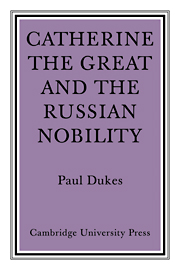 Catherine the Great and the Russian Nobilty
Catherine the Great and the Russian Nobilty 4 - Social and political attitudes
Published online by Cambridge University Press: 31 March 2010
Summary
QUALIFICATIONS FOR NOBILITY
Who was a dvorianin? If anybody definitely knew the answer to this important question in 1767, it should have been the Heraldmaster. But his office confessed in its instruction that it was not certain what the qualifications for dvorianstvo were. On 5 February 1722, about two weeks after the publication of the Table of Ranks, the instruction pointed out, the order had been given that information concerning all Russian nobles should be sent to the Heraldmaster, but, it went on to say, ‘up to now accurate information on nobles and their children, in service and retired, also deceased and newly born, has still not been received from all regions’. Particularly, the office possessed no records concerning the Ukraine, Smolensk, Livonia, Estonia and Finland, and foreign nobles in Russian service. Therefore, the instruction lamented, ‘a genealogical register of dvoriane, in which all families of Russian nobles would be inscribed, is not at the Heraldmaster's Office’. Moreover, apart from the lack of information, a further impediment to the compilation of a genealogical record was the doubt concerning the qualifications for dvorianstvo. Was this to be proved by service rank, possession of an estate, or both? A more definite ruling was required, the Heraldmaster's Office considered, about the status of those who had received commissioned rank in the army and secretaryship in the civil service.
- Type
- Chapter
- Information
- Catherine the Great and the Russian NobiltyA Study Based on the Materials of the Legislative Commission of 1767, pp. 145 - 188Publisher: Cambridge University PressPrint publication year: 1967


